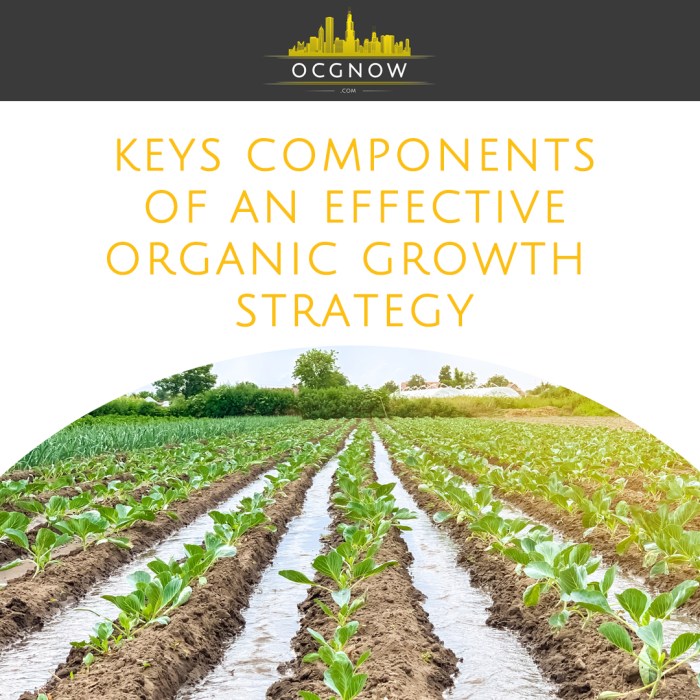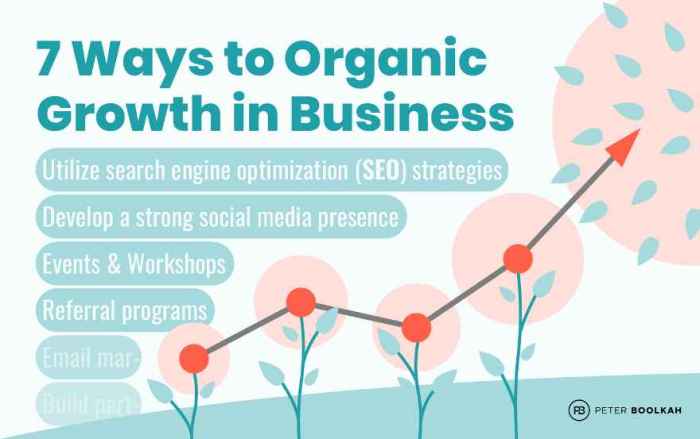Kicking off with Understanding Organic Growth, this topic dives into the essence of business growth through natural means. Think of it as businesses leveling up without any cheat codes, just pure growth strategies at play.
As we unravel the layers of organic growth, you’ll discover the secrets behind sustainable business expansion and how market conditions and customer acquisition play a crucial role in this game.
What is Organic Growth?

Organic growth in the business context refers to the natural expansion and development of a company through internal resources and strategies, rather than relying on mergers, acquisitions, or other external factors. It involves increasing sales, expanding market share, and improving profitability through the company’s own efforts and existing operations.
Differences Between Organic and Inorganic Growth
Organic growth differs from inorganic growth in that it is achieved through internal means such as improving product offerings, expanding into new markets, and increasing customer base gradually over time. On the other hand, inorganic growth involves mergers, acquisitions, or partnerships with other companies to achieve rapid expansion and market presence.
Examples of Companies with Significant Organic Growth
– Apple: Apple has achieved significant organic growth through continuous innovation in its products, expanding its customer base, and increasing market share in various technology sectors.
– Starbucks: Starbucks has grown organically by opening new stores, introducing new products, and focusing on customer experience to drive sales and profitability.
– Netflix: Netflix has experienced remarkable organic growth by investing in original content, expanding globally, and adapting to changing consumer preferences to become a leading streaming service provider.
Factors Influencing Organic Growth
Organic growth in businesses is influenced by various factors that play a crucial role in driving sustainable and long-term success. These factors can range from internal strategies to external market conditions that impact the overall growth trajectory of a company.
Internal Factors
- Strong Leadership: Effective leadership that fosters innovation and empowers employees to take risks can lead to organic growth.
- Culture of Continuous Improvement: Encouraging a culture where learning and development are prioritized can drive organic growth through increased productivity and efficiency.
- Customer-Centric Approach: Putting customers at the center of business decisions can result in higher customer retention and acquisition rates, ultimately fueling organic growth.
External Factors
- Market Conditions: Fluctuations in the market, such as changes in consumer preferences or economic trends, can significantly impact organic growth strategies.
- Competitive Landscape: Understanding and adapting to competitive pressures can help businesses identify new opportunities for growth and stay ahead in the market.
- Regulatory Environment: Compliance with regulations and policies can create a stable operating environment for businesses to pursue organic growth initiatives.
Successful Strategies for Fostering Organic Growth, Understanding Organic Growth
- Product Innovation: Developing new and improved products/services that meet customer needs can drive organic growth by expanding market share.
- Strategic Partnerships: Collaborating with other businesses or industry partners can open up new avenues for growth and market expansion.
- Data-Driven Decision Making: Leveraging data analytics to make informed business decisions can lead to more effective strategies for organic growth.
Understanding Customer Acquisition for Organic Growth: Understanding Organic Growth
Customer acquisition plays a crucial role in organic growth as it involves attracting new customers to the business, increasing revenue, and expanding market reach. It is essential for businesses to focus on acquiring customers effectively to sustain long-term growth.
Importance of Customer Acquisition in Organic Growth
Customer acquisition is vital for organic growth as it helps businesses to continuously increase their customer base, leading to higher sales and revenue. By acquiring new customers, businesses can expand their market presence and stay ahead of competitors. Moreover, a growing customer base provides a stable foundation for sustainable growth and long-term success.
Comparison of Customer Acquisition Strategies for Organic vs. Inorganic Growth
Organic customer acquisition strategies focus on attracting customers through content marketing, social media engagement, , and word-of-mouth referrals. These methods aim to build trust and relationships with customers over time, resulting in loyal and engaged customers.
In contrast, inorganic customer acquisition strategies involve purchasing customer lists, running paid advertising campaigns, or acquiring other businesses to gain their customer base. While these strategies may lead to quick customer acquisition, they often lack the same level of loyalty and engagement as organically acquired customers.
Insights on Customer Retention for Sustaining Organic Growth
To sustain organic growth, businesses need to focus on retaining customers by providing exceptional customer service, personalized experiences, and ongoing communication. By building strong relationships with existing customers, businesses can increase customer loyalty, drive repeat purchases, and generate positive word-of-mouth referrals. Retaining customers is key to maintaining a steady revenue stream and fostering long-term growth.
Leveraging Technology for Organic Growth

Technology plays a crucial role in driving organic growth for businesses in today’s digital landscape. By harnessing innovative technological solutions and leveraging data analytics, companies can optimize their strategies to attract and retain customers, expand their market reach, and ultimately achieve sustainable growth.
Innovative Technological Solutions for Organic Growth
- Artificial Intelligence (AI) and Machine Learning: AI-powered tools can analyze customer behavior patterns, predict trends, personalize marketing campaigns, and improve overall customer experience.
- Customer Relationship Management (CRM) Systems: CRM platforms help businesses track customer interactions, manage leads, and tailor communication strategies based on customer preferences.
- E-commerce Platforms: Setting up online stores and utilizing digital payment gateways enable businesses to tap into a global customer base and streamline the purchasing process.
- Social Media Marketing Tools: Platforms like Hootsuite and Buffer allow companies to schedule posts, engage with customers, and monitor social media performance to drive organic traffic.
Role of Data Analytics in Optimizing Organic Growth Strategies
Data analytics empowers businesses to make informed decisions by extracting valuable insights from large volumes of data. By analyzing customer preferences, market trends, and performance metrics, companies can enhance their product offerings, target the right audience, and allocate resources effectively to drive organic growth. Utilizing tools like Google Analytics, businesses can track website traffic, monitor conversion rates, and optimize marketing strategies for better results.






